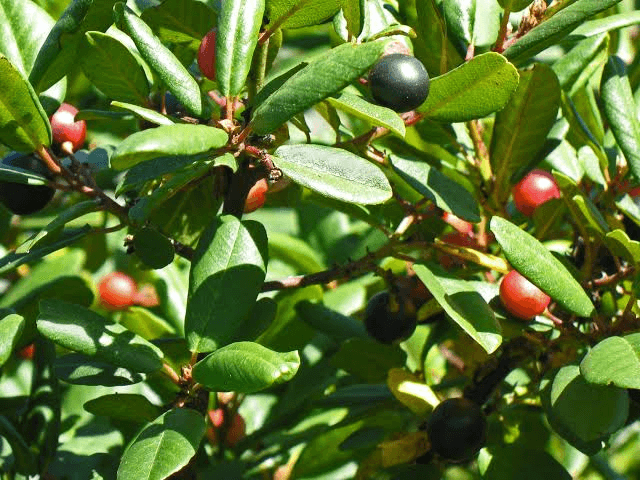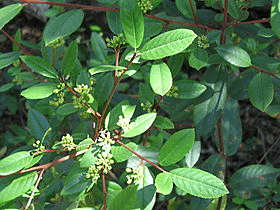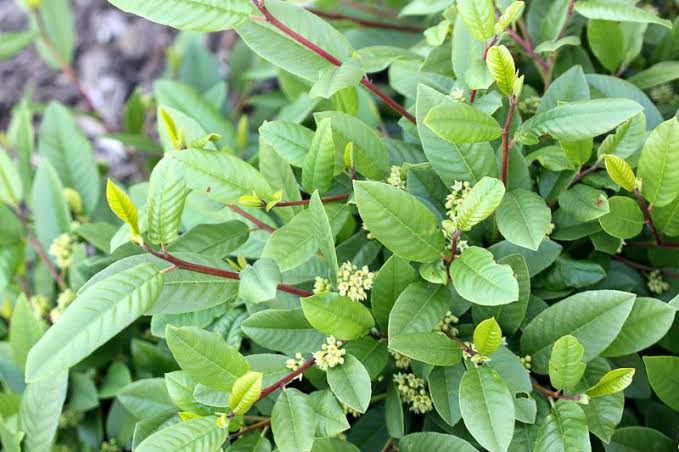Frangula californica, commonly known as California Buckthorn, is a native shrub that thrives in the diverse landscapes of California and the western United States. This deciduous plant is renowned for its unique and versatile characteristics. Its distinctive lance-shaped leaves are typically dark green, creating a vibrant contrast with its small, inconspicuous greenish-yellow flowers.
However, it’s the fruit that truly sets this species apart. California Buckthorn produces clusters of small, bright red berries that add a splash of color to the shrub and are a vital food source for local wildlife.
This hardy shrub is well-adapted to a variety of ecosystems, from coastal regions to mountain slopes. It plays a crucial role in stabilizing soils, preventing erosion, and enhancing biodiversity by providing habitat and sustenance for numerous birds and insects.
Moreover, the California Buckthorn has historical and cultural significance among indigenous peoples who used its bark for medicinal purposes and its wood for tools and utensils. It is a resilient and valuable species that exemplifies the ecological importance of native plants in California’s unique and diverse ecosystems.
Gardeners and horticulturists also appreciate California Buckthorn for its ornamental qualities. It can be an attractive addition to gardens and landscapes, offering year-round interest with its foliage, flowers, and berries. Whether for its ecological benefits or its aesthetic appeal, Frangula californica is a fascinating and valuable plant that enriches the natural and cultivated landscapes of California.
The Botanical Description of Frangula californica (California Buckthorn)
Frangula californica, commonly known as California Buckthorn, is a native shrub found in the western United States and parts of Mexico. Its botanical description provides insights into its characteristics and features:
1. Plant Size: California Buckthorn is a deciduous shrub that can reach heights of 6 to 15 feet (1.8 to 4.6 meters). It has a spreading and bushy growth habit.
2. Leaves: The leaves of Frangula californica are simple, alternate, and typically ovate or elliptical in shape. They are glossy, dark green, and can measure 1 to 3 inches (2.5 to 7.6 cm) in length. The leaves have prominent veins and serrated margins.
3. Flowers: The shrub produces small, inconspicuous flowers that are greenish-yellow and often bloom in clusters. These flowers are typically unisexual, with male and female flowers occurring on separate plants.
4. Fruits: The fruit of California Buckthorn is a small, round drupe that starts green and matures to a dark purple-black color. The fruits are approximately 1/4 inch (0.6 cm) in diameter and contain one to three seeds.
5. Bark: The bark of Frangula californica is smooth, gray to brown in color, and develops distinctive lenticels (pores) as it matures.
6. Habitat: This shrub is well-suited to a variety of habitats, including chaparral, woodlands, and riparian areas. It’s commonly found in California, where it thrives in the wild.
7. Native Range: Frangula californica is native to the western United States, including California, Oregon, and Nevada, as well as parts of northwestern Mexico.
8. Growth and Development: California Buckthorn grows at a moderate pace and is adaptable to different soil types. It is a hardy shrub, tolerating drought conditions and some level of soil salinity.
9. Ecological Importance: This plant plays a vital role in the ecosystem as a source of food for birds and wildlife. Its berries are consumed by various bird species, aiding in seed dispersal.
10. Cultivation: Frangula californica is also cultivated for its ornamental value, especially in native and drought-tolerant landscaping. It adds beauty to gardens while providing ecological benefits.
The Geographic Distribution of Frangula californica (California Buckthorn)
Frangula californica, commonly known as California Buckthorn, exhibits a specific geographic distribution, which is vital for understanding its natural habitat and potential areas for cultivation. Here’s a detailed overview of its geographical presence:
1. Native Regions: California Buckthorn is primarily native to the western United States, including California, Oregon, and Nevada. It also extends into northwestern Mexico, particularly in Baja California.
2. Habitat: This shrub thrives in a variety of habitats, including chaparral, coastal sage scrub, woodlands, and riparian areas. It is well-adapted to arid and semi-arid regions, making it a common sight in California’s diverse landscapes.
3. Altitude: California Buckthorn can be found at varying altitudes, ranging from sea level to elevations of up to 5,000 feet (1,524 meters) above sea level. Its ability to grow at different elevations contributes to its wide geographic distribution.
4. Soil Preferences: Frangula californica demonstrates adaptability to different soil types, including well-drained sandy soils and clay-rich soils. It often grows in areas with adequate sunlight and good drainage.
Understanding the natural geographic distribution of California Buckthorn is essential for conservation efforts and ensures its sustainable utilization in various regions.
The Chemical Composition of Frangula californica (California Buckthorn)
The chemical composition of Frangula californica is of great interest to researchers and herbalists due to its potential medicinal applications. Here’s an insight into the key components found in this plant:
1. Anthraquinones: California Buckthorn contains anthraquinone compounds, including emodin and chrysophanol. These compounds contribute to the plant’s laxative properties and are often utilized in traditional herbal medicine.
2. Flavonoids: Flavonoids, such as quercetin and kaempferol, are present in California Buckthorn. These antioxidants play a role in various biological activities, including anti-inflammatory and anti-cancer effects.
3. Tannins: Tannins are polyphenolic compounds found in Frangula californica. They contribute to the plant’s astringent properties and are often used in herbal remedies for their ability to tighten and tone tissues.
4. Coumarins: Coumarins, such as scopoletin, are present in this shrub. Coumarins have diverse pharmacological properties and are being studied for their potential therapeutic applications.
5. Essential Oils: California Buckthorn may contain essential oils, although their composition can vary. These oils can have antimicrobial and aromatic properties.
The chemical composition of Frangula californica provides a foundation for its traditional uses and ongoing research into its potential medicinal benefits.
The Harvesting and Processing of Frangula californica (California Buckthorn)
The harvesting and processing of California Buckthorn are crucial steps that impact the plant’s quality and efficacy in medicinal applications. Here’s a detailed overview of the harvesting and processing methods:
1. Harvesting: California Buckthorn berries are typically harvested when they are fully ripe, which is when they turn from green to a dark purple-black color. Harvesters need to be cautious and selective, ensuring that only mature berries are collected for use.
2. Drying: Once harvested, the berries are carefully cleaned to remove any impurities and then dried thoroughly. Drying is a vital step to prevent mold and preserve the berries for extended use. Proper ventilation and low humidity are essential during the drying process.
3. Storage: Dried California Buckthorn berries should be stored in airtight containers away from direct sunlight and moisture. Proper storage conditions help maintain their potency and prevent contamination.
4. Processing: In traditional herbal medicine, the dried berries are often used to prepare teas, tinctures, or herbal infusions. The processing methods can vary, with some herbalists choosing to crush the berries before use to enhance their potency.
Understanding the appropriate harvesting and processing techniques ensures that the medicinal properties of California Buckthorn are preserved, providing herbalists and consumers with a reliable natural remedy.
Read Also: 23 Medicinal Health Benefits Of Melilotus officinalis (Yellow Sweet Clover)
The Medicinal Health Benefits Of Frangula californica (California Buckthorn)

Frangula californica, commonly known as California Buckthorn, has been used in traditional herbal medicine for its potential health benefits. Here are 20 medicinal advantages associated with this plant:
1. Laxative Properties: California Buckthorn is well-known for its gentle laxative effects, making it useful for relieving constipation.
2. Digestive Aid: It can support healthy digestion and alleviate gastrointestinal discomfort.
3. Detoxification: California Buckthorn is believed to assist the body in eliminating toxins and waste.
4. Weight Management: Some use it as part of weight management regimens due to its potential impact on bowel regularity.
5. Skin Health: It’s been traditionally applied topically for skin conditions, such as rashes and irritations.
6. Antioxidant Effects: California Buckthorn’s flavonoids may provide antioxidant benefits, protecting cells from oxidative stress.
7. Anti-Inflammatory: It’s used to reduce inflammation in various parts of the body.
8. Immune Support: The plant may help strengthen the immune system.
9. Heart Health: Some believe it has potential benefits for cardiovascular health.
10. Hemorrhoid Relief: California Buckthorn is utilized to alleviate discomfort associated with hemorrhoids.
11. Antimicrobial Properties: It may have antimicrobial effects, combating certain pathogens.
12. Astringent Qualities: Its tannins contribute to its astringent properties, often used to tighten tissues.
13. Anti-Cancer Potential: Some research suggests that compounds in the plant may have anti-cancer properties.
14. Liver Support: It’s used to promote liver health and function.
15. Anti-Anxiety: California Buckthorn may help reduce anxiety and promote relaxation.
16. Bone Health: It’s believed to support bone health due to its mineral content.
17. Kidney Function: Traditional uses include supporting kidney function.
18. Respiratory Health: It’s sometimes used to alleviate respiratory issues.
19. Urinary Tract Health: It may help maintain a healthy urinary tract.
20. General Well-Being: Many use California Buckthorn as a general tonic for overall well-being.
The Methods of Usage to Achieve the Provided Health Benefits Of Frangula californica (California Buckthorn)
To harness the health benefits of California Buckthorn, various methods of usage are employed:
1. Herbal Tea: One common method is to prepare a herbal tea using dried California Buckthorn berries. This tea is consumed to aid digestion and support regular bowel movements.
2. Tinctures: Tinctures are alcohol-based extracts of the plant and are used in precise dosages for their medicinal effects.
3. Capsules and Supplements: California Buckthorn is available in capsule form or as a supplement, providing a convenient way to incorporate it into your daily routine.
4. Topical Applications: For skin conditions and irritations, the plant’s extracts can be applied topically in ointments or creams.
5. Traditional Remedies: Traditional healers often have their own methods for preparing and using California Buckthorn for specific health concerns.
It’s essential to use California Buckthorn with care and consult with a healthcare professional or herbalist to determine the most suitable method and dosage for your specific health needs.
The Side Effects Of Using Frangula californica Medicinal Plant
While California Buckthorn offers several health benefits, it’s important to be aware of potential side effects:
1. Diarrhea: Overuse can lead to excessive bowel movements and diarrhea.
2. Dehydration: Frequent diarrhea can lead to dehydration if not managed properly.
3. Potassium Loss: Prolonged or excessive use may result in potassium loss.
4. Abdominal Discomfort: Some individuals may experience abdominal cramps or discomfort.
5. Skin Irritation: When applied topically, it may cause skin irritation in some cases.
6. Interactions: California Buckthorn may interact with certain medications, so consult with a healthcare professional if you are taking other drugs.
7. Pregnancy and Lactation: It’s not recommended for use during pregnancy and breastfeeding.
As with any herbal remedy, it’s crucial to use California Buckthorn in moderation and under the guidance of a healthcare provider to avoid potential side effects and interactions.
Read Also: 22 Medicinal Health Benefits of Garcinia Indica (Kokum)
Scientific Research and Studies of Frangula californica (California Buckthorn)

Numerous scientific studies and research have explored the potential health benefits and safety of Frangula californica, commonly known as California Buckthorn. Here are some key findings:
1. Laxative Effects: Several studies have confirmed the plant’s laxative properties. Research indicates that it can effectively relieve constipation without causing irritation or dependency.
2. Gastrointestinal Health: Scientific investigations have shown that California Buckthorn can promote healthy digestive processes, potentially reducing discomfort associated with indigestion and bloating.
3. Antioxidant Activity: The plant’s high flavonoid content contributes to its antioxidant effects, which protect cells from oxidative damage and inflammation.
4. Anti-Inflammatory Properties: Studies suggest that California Buckthorn has anti-inflammatory potential, which may be beneficial for various inflammatory conditions.
5. Immune System Support: Some research has explored its role in strengthening the immune system, potentially making the body more resistant to infections.
6. Skin Health: Preliminary studies indicate that California Buckthorn extracts may be used in skincare products to alleviate skin irritations and promote overall skin health.
7. Potential Anti-Cancer Properties: Certain compounds found in the plant have demonstrated anti-cancer potential in laboratory settings, although more research is needed to establish clinical significance.
8. Cardiovascular Benefits: California Buckthorn may positively impact heart health by lowering cholesterol levels and supporting overall cardiovascular function.
9. Safety in Moderation: Research highlights that California Buckthorn is generally safe when used in moderation. However, excessive use may lead to side effects, such as diarrhea.
10. Interaction with Medications: Studies suggest that the plant may interact with specific medications, particularly those affecting potassium levels or electrolyte balance. It’s crucial to consult with a healthcare provider if you’re taking other drugs.
Safety Precautions and Recommendations In Using Frangula californica (California Buckthorn) Medicinal Plant
While California Buckthorn offers potential health benefits, it should be used with care. Here are some safety precautions and recommendations:
1. Dosage: Follow recommended dosages carefully to avoid potential side effects like diarrhea and dehydration.
2. Hydration: When using California Buckthorn, drink plenty of water to prevent dehydration.
3. Potassium Levels: Monitor your potassium levels, especially if you have underlying health conditions or are taking medications that affect potassium.
4. Pregnancy and Breastfeeding: Avoid using California Buckthorn during pregnancy and while breastfeeding, as it can lead to uterine contractions and potential harm to the fetus or infant.
5. Consult a Healthcare Provider: Before using California Buckthorn, consult with a healthcare provider, especially if you have existing health conditions or are taking other medications.
6. Skin Irritation: When using California Buckthorn topically, conduct a patch test to check for skin sensitivity or irritation.
FAQs About Frangula californica (California Buckthorn) Medicinal Plant
Here are answers to 18 frequently asked questions about California Buckthorn:
1. Is California Buckthorn safe for daily use?
California Buckthorn is generally safe for occasional use, but daily use may lead to side effects. Follow recommended dosages.
2. Can it be used during pregnancy?
It’s not recommended during pregnancy, as it can cause uterine contractions.
3. What are the potential side effects of California Buckthorn?
Side effects may include diarrhea, dehydration, and potassium loss.
4. Can it be used for weight loss?
Some people use it as part of weight management due to its laxative properties, but it’s not a weight loss solution.
5. Is it safe for children?
Use with caution in children, and consult a pediatrician for appropriate dosages.
6. How long does it take for California Buckthorn to work as a laxative?
The onset of action varies but usually occurs within 6 to 12 hours.
7. Can it interact with medications?
California Buckthorn may interact with medications affecting potassium levels, so consult with your healthcare provider.
8. Can it be used for chronic constipation?
Consult a healthcare provider for chronic constipation, as frequent use may lead to dependency.
9. What parts of the plant are used medicinally?
The berries and bark are commonly used.
10. Are there specific contraindications for California Buckthorn?
Avoid use in cases of intestinal blockage, appendicitis, and severe dehydration.
11. Can it be used as a topical treatment for skin conditions?
California Buckthorn can be applied topically for skin irritations.
12. Is it available as an over-the-counter supplement?
Yes, you can find it in various forms, including capsules and tinctures.
13. Can it be used as a long-term herbal remedy?
Long-term use should be monitored by a healthcare provider due to potential side effects.
14. Does it have a pleasant taste when used in teas or infusions?
California Buckthorn has a bitter taste, which some people may find unpleasant.
15. Can it be used in combination with other herbal remedies?
Consult a healthcare provider before combining herbal remedies.
16. What are the best storage conditions for California Buckthorn supplements?
Store them in a cool, dry place away from direct sunlight.
17. Can it be grown at home for personal use?
Yes, it can be grown as a shrub in gardens.
18. Does it have cultural or traditional significance in herbal medicine?
California Buckthorn has a history of use in Native American traditional medicine for various ailments.
Read Also: Complete Non-Biodegradable Waste Management Guide






